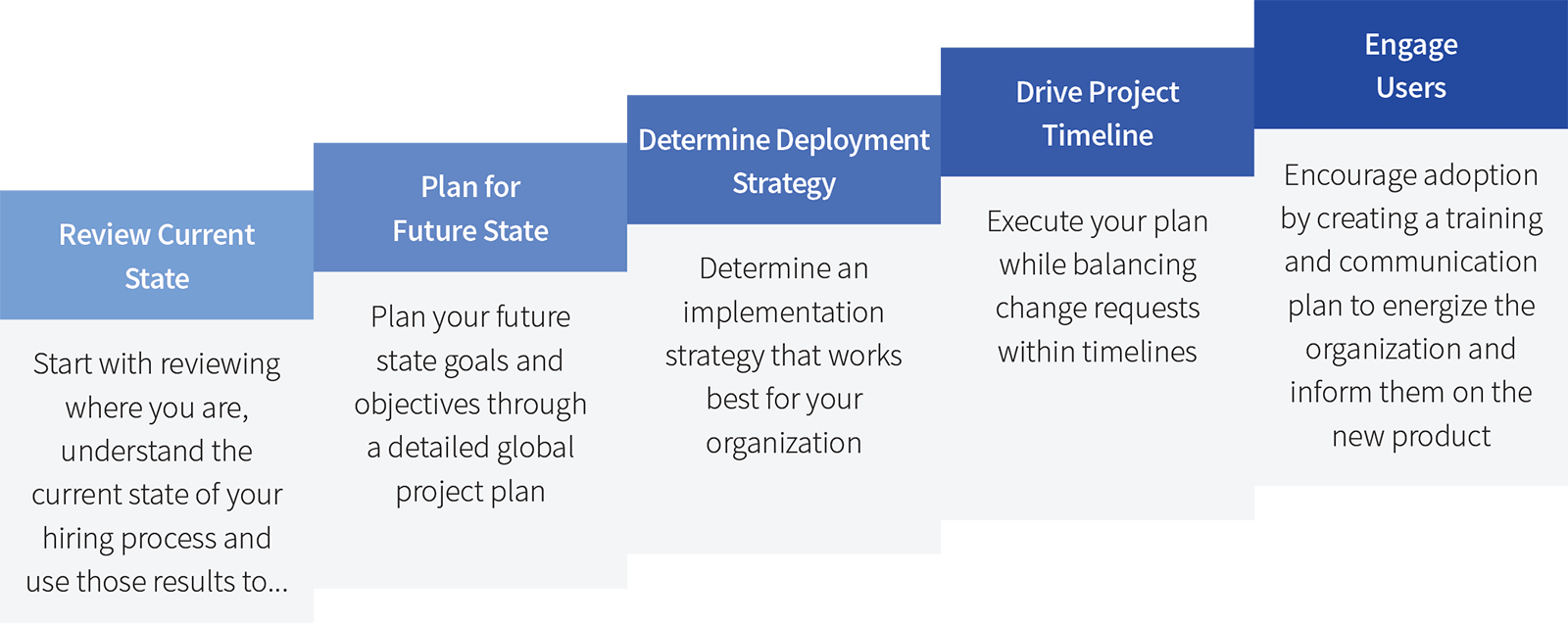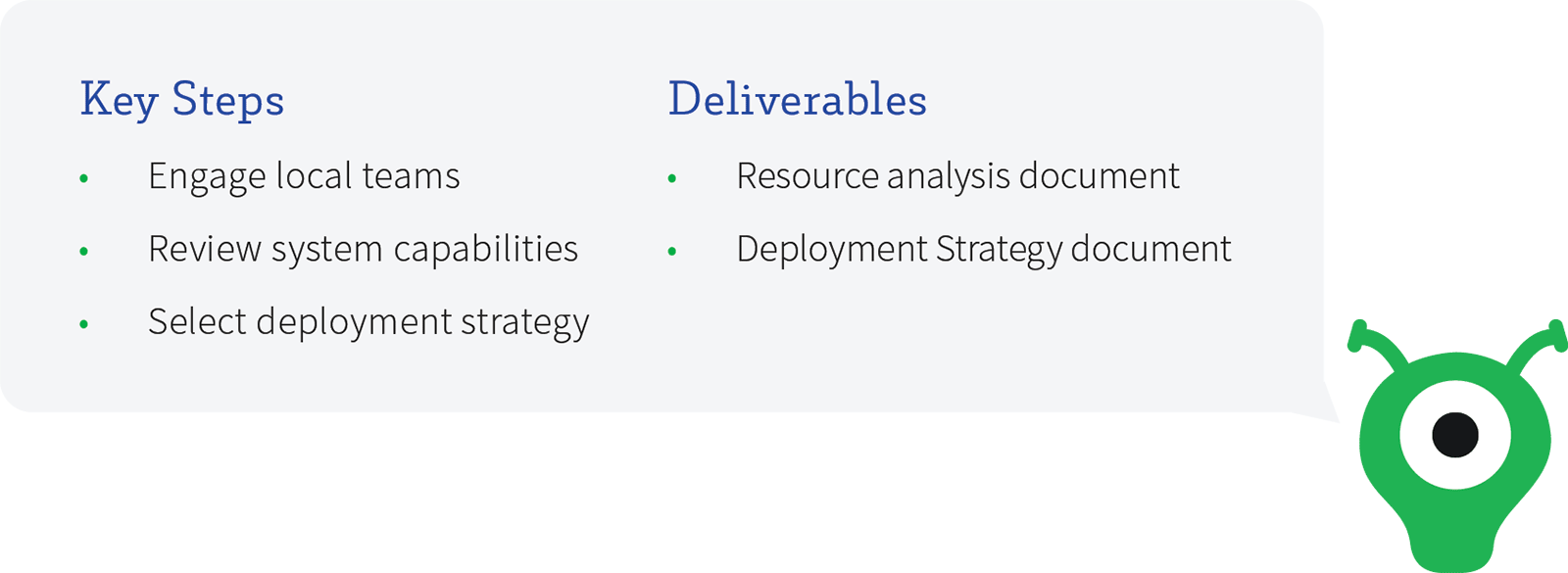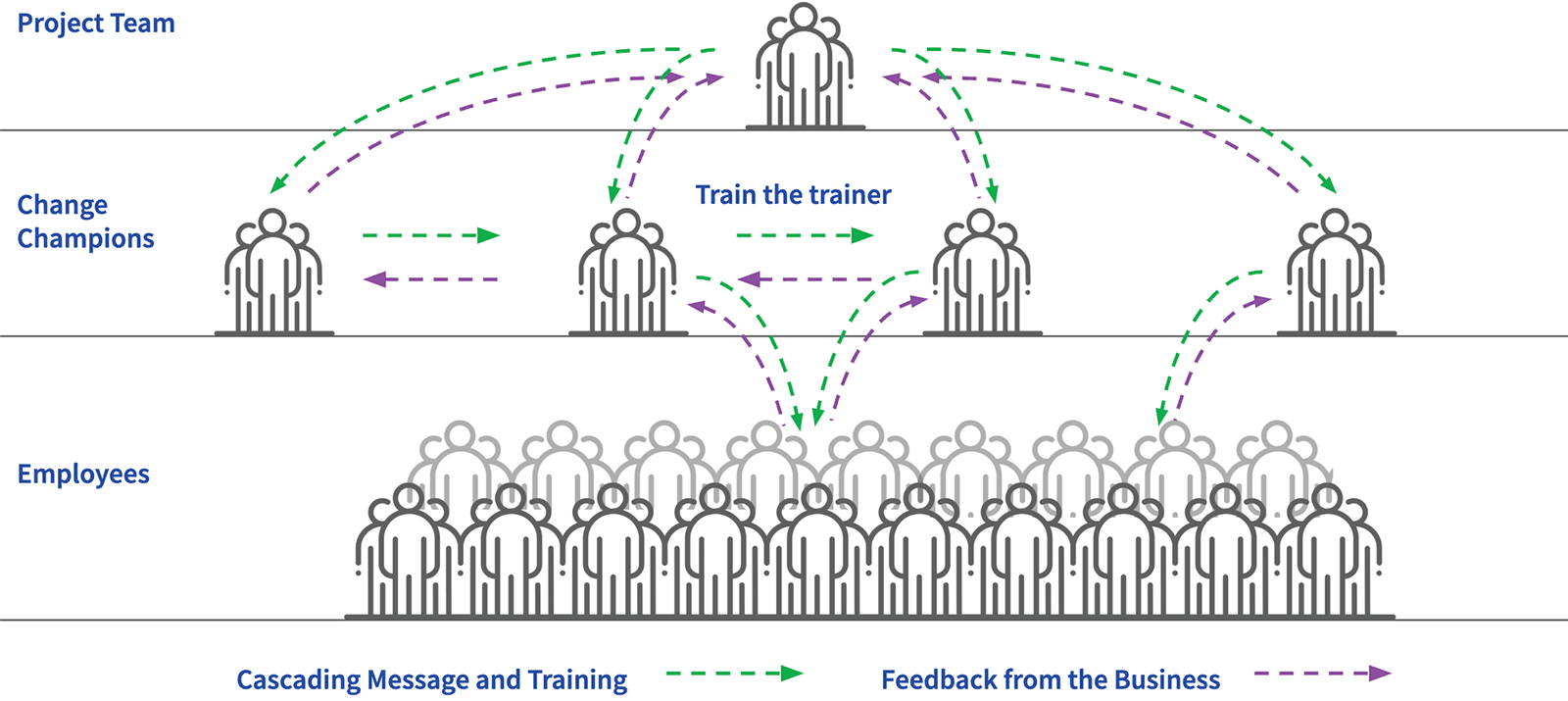Continue Reading
Implementation
Now that you know where you want to go, who/what is involved, and how to get there successfully, the next step is enacting change! Implementation is the process of designing your system to meet your needs and goals. It guides how your users will adopt the new recruiting technology.
Strong adoption and engagement will ensure your team has the tools in place to achieve Hiring Success and enable measurable business outcomes.
Additionally, a successful implementation process builds trust between the customer and technology provider. This trust-building exercise enables further opportunities for deeper partnerships in future endeavors.
A word of caution: there are potential risks if implementation does not go as planned. Chiefly losing out on the ability to attract the best talent. Additionally, you could run the risk of low user adoption rates and employee compliance violations. Remember, you’ve worked so hard to choose the right technology and spent precious time evaluating vendors—don’t let those efforts go to waste!
Now, let’s dive deeper and review a high-level framework for successfully deploying a new talent acquisition suite, from beginning to end.

Review Current State
The first step to a successful implementation begins with an appraisal of current state. Establishing a baseline will help you measure and track important elements of your rollout like project resources, scope, budget, and timeline. Prior to this exercise, be prepared to have the following information ready for your technology partner:
- Which metrics do you track?
- What is your current hiring process?
- Who is involved in hiring?
- What are the local legal requirements?
- Which local deviations to global processes will continue to be supported?
- Are there multiple brands to support?
- Which existing job boards do you use?
- Which assessments and third party vendors do you plan to integrate to your ATS?
Next, identify the owners of key recruiting processes (functional and technical) and request the following input: What’s the purpose of having an ATS? Why is it important? What is currently working well? What’s not?

Plan for Future State
Now you’ll need to create a detailed project plan that will deliver your vision of the future state. Your plan should answer the following questions:
- What project resources are available to support?
- Who will assist with system configuration during the project and beyond?
- Are there compelling events to plan the launch around?
- Are internal resources available to support training and change management?
Work backwards from your desired end state to determine feasibility and timeline. This will also inform whether a phased or big bang approach makes more sense for your project.
When you approach a crossroads regarding deployment decisions, engage with different teams. This will drive buy-in for the project and foster the growth of project champions.
You can avoid configuration errors by limiting administrator access to key resources.
Deployment Strategy
After reviewing your current state, defining future state objectives, and understanding project resourcing, your next step is to review the deployment strategy. There are four general strategies that we recommend at SmartRecruiters (see figure below) – each comes with its unique benefits & risks. It’s best to collaborate with your global and local offices, and your Technology Partner, to weigh the benefits & risks of each approach.
| Strategy | What Is Involved? | Benefits | Risks | Best For… |
|---|---|---|---|---|
Big Bang |
All capabilities, all locations, all users. | Consistency from day one. Everyone in the same system using the system process. | Too much too fast, local teams not prepared to support process. | Mature companies with global processes and resources aligned to support it. |
Critical Few |
Target specific teams/ business units/ specialties for deployment timeline. | Create super users naturally, identify process breaks and fix before releasing to all users. | Sections of the process are still completed outside of the system. | Companies with large recruiting teams – start there and gradually bring in other users. |
World Tour |
Target specific locations for deployments timeline. | More mature processes can lead the way for future locations. | Local teams do not feel included in the roll out. | Companies with emerging/ immature global locations but waiting for resources to support the local process. |
Simple Start |
Target specific capabilities before launching, vet out processes and integrations. | Opportunity to pilot specific features to isolate process breaks or inefficiencies. | Feature dependency, creating a behavior where the other system functionality is ignored. | Companies focused on key system functionality or waiting for future product releases. |

Project Timeline
Now comes the fun part: customizing and configuring your system! During this step, you should work with your provider to ensure the implementation of the platform is in line with the approved scope and collaborate with your stakeholders on system configuration, integrations, testing, training, deployment and stabilization activities.
Execution Activities
- Build and configure all elements of the data model, forms, email templates, workflows, views, access controls
- Support configuration/integration elements
- Define and document the requirements for user acceptance testing, management of defects, defect life cycle, testing documentation, and scripts
- Support user acceptance testing and manage all identified defects, working closely with SmartRecruiters and your internal stakeholders
- Define and document the requirements for training and build a training plan matrix

Keep in mind that across all industries, only 50% of IT projects meet their stated goals. In order to be part of the right half, the balance between organizational agility and execution of the project plan is key.
Walking this fine line requires effective planning, agile teams, and open & consistent communication. There are several best practices we recommend to help keep your project on track:
With product enhancements and releases occurring so often, change requests are inevitable so plan ahead.
When a change is requested, be sure to check if it is required and be ready to remind project teams and other stakeholders of the original vision.
Make sure resources are assigned to the project early and included in the project kick off. Consider all technical dependencies outside of the project that may impact your overall timeline.
Calculate expected costs before initiating the project and require approval before work can begin. Ensure all team members utilize a time trackingtool daily so you have real-time visibility into project burn rate.

User Engagement
Congrats—you’ve made it this far! You’ve reviewed your current state, designed your future state, built a plan, and executed it. Now it’s time to share your hard work with the rest of the organization. Resistance to change will happen, particularly among employees who are comfortable in their current processes. However, as we saw in the earlier example of effective change management, with the right approach you can successfully build support, adoption, and excitement for your new system.
Start by finding your champions—super users outside the project team who will inspire adoption and engagement. Give these super users a special title and provide them with incentives to motivate and train their colleagues. Find your champions early and regularly update them on the status of the project. Also be sure to clearly outline your expectations for them.
Remember: it’s important to devise and implement strategic communication and training plans to engage users. Communicating what you’re doing early on—and often—will result in greater interest and, eventually, higher rates of adoption.
Now you’ll need to train your users to ensure competency and successful adoption.
In fact, our implementation experts recommend at least 25% of your project budget should be allocated to training.
The most efficient and cost-effective way of doing so is through Train-the-Trainer sessions with internal trainers and system champions. These sessions usually cover both basic and advanced system knowledge, with some emphasis placed on the development of soft skills. For administrators and system champions, we suggest more detailed training sessions with certification tests. This will ensure that your organization has a cohort of knowledgeable, competent users who can train and onboard others in the future.

| Template: Communicating a New ATS To Your Organization |
|---|
|
What is SmartRecruiters? How will this affect me? If you are not a hiring manager, SmartRecruiters is an excellent tool to apply or refer others to internal positions. Can I help recruit? |
Once you’ve launched, be sure to publicly announce which individuals will act as champions to support internal users. Additionally, you should nominate someone to take ownership of tasks like error documentation/resolution, password management, and new hire onboarding. Putting these measures in place will ensure a smooth transition, especially within the first three months of launch.
